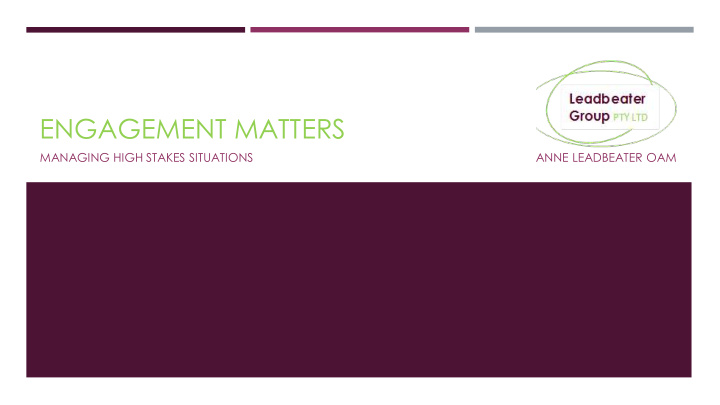



ENGAGEMENT MATTERS MANAGING HIGH STAKES SITUATIONS ANNE LEADBEATER OAM
THREE STORIES…
Story 2 : Bushfire Buy Back Scheme Pine Ridge Road, Kinglake West 15 fatalities Every house destroyed ‘ Close to bush and posing an unacceptably high threat to human safety …’ Recommendation 46: The State develop and implement a retreat and resettlement strategy for existing developments in areas of unacceptably high bushfire risk, including a scheme for non- compulsory acquisition by the State of land in these areas.
Story 3 : Bushfire Neighbourhood Safer Places
What do these stories have in common? They. Meant. Well.
What makes a situation ‘high stakes’? Responsibilities Grief – Trauma Scale – Damage – Disruption – Loss Politics Fatalities Media Failures – legislation, policy, process Reputational Risk Community Outrage Blame
Systems theory Patterns of leadership and of authority in disaster impacted communities are very complex. Their complexity however, is usually misinterpreted as confusion and a panacea of strong [external] leadership is frequently offered as a solution without understanding the nature of the problem. Dynes and Quarantelli 1972 www.terro.com
So, how do we work when the stakes are high? Bureaucratic or government response occurs alone or in a vacuum Information outside of official channels is lacking or inaccurate Standard operating procedures will always function and be adequate in disaster situations Departures from bureaucratic guidelines may be detrimental Pre-disaster social structure is weak and disjointed Citizens are inept, passive or non-participants in disaster operations Emergency events depart sharply from pre-disaster behaviour Society breaks down during disaster Disaster is characterised by irrational victim behaviour such as panic or looting Ad hoc emergence is counterproductive. Whittaker et al. 2015, citing Drabek and McEntire, (2003)
How should we work when the stakes are high? Emergencies may create some degree of confusion and disorganisation at the level of routine organisational patterns but to describe that as social chaos is incorrect. Emergencies do not reduce the capacities of individuals or social structures to cope. They may present new and unexpected problems to solve. Existing social structure is the most effective way to solve those problems. To create an artificial, emergency-specific authority structure is neither possible nor effective. Planning efforts should be built around capacity of social units to make rational and informed decisions. These social units need to be seen as resources for problem solving, rather than as the problems themselves. An emergency by its very nature is characterised by decentralised and pluralistic decision making, so autonomy of decision making should be valued, rather than the centralisation of authority. An open system is required in which a premium is placed on flexibility and initiative among the various social units, and those efforts are coordinated. The goals should be oriented towards problem solving, rather than avoiding chaos. Whittaker et al. 2015, citing Quarantelli (1988) and Dynes (1994)
CHAOS Continuity Coordination Command Cooperation and Control
One person can make a difference and everyone should try. John F. Kennedy
Recommend
More recommend